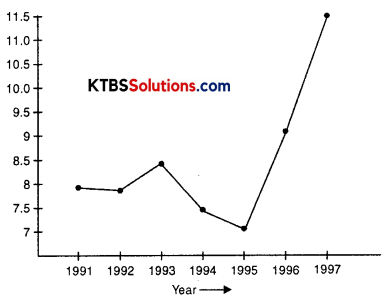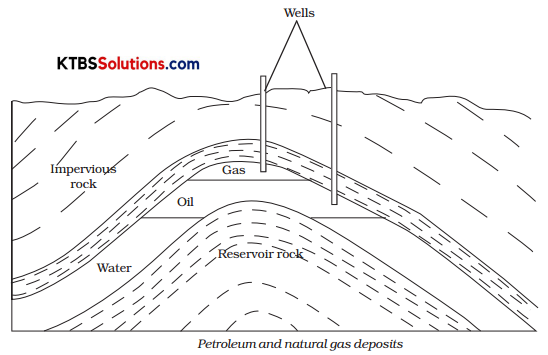You can Download KSEEB Solutions for Class 8 Science Chapter 5 Coal and Petroleum Questions and Answers Pdf, Notes help you to revise the complete syllabus.
KSEEB Solutions for Class 8 Science Chapter 5 Coal and Petroleum
Coal and Petroleum Textbook Questions and Answers
Question 1.
What are the advantages of using CNG and LPG as fuels?
Answer:
The advantages of using CNG and LPG as fuels are:
- It burns without producing any smoke.
- It burns completely and does not leave behind any residue.
- It can be easily ignited.
- It can be transported to distant places through pipelines.
- It has a high heat value.
Question 2.
Name the petroleum product used for surfacing roads.
Answer:
Bitumen.
![]()
Question 3.
Describe how coal is formed from dead vegetation. What is this process called?
Answer:
About 300 million years ago, the earth had dense forests in low-lying wetland areas. Due to natural processes, like flooding, these forests got buried under the soil. As more soil deposited over them, they were compressed. The temperature also rose as they sank deeper and deeper. Under high pressure and high temperature, dead plants got slowly converted to coal. This process is called carbonization.
Question 4.
Fill in the blanks.
- Fossil fuels are ______, ________ and ________
- Process of separation of different constituents from petroleum is called ________
- Least polluting fuel for vehicle is ________
Answer:
- coal, petroleum, and natural gas
- refining
- CNG
Question 5.
Write True/False against the following statements:
- Fossil fuels can be made in the laboratory.
- CNG is more polluting fuel than petrol.
- Coke is almost a pure form of carbon.
- Coal tar is a mixture of various substances.
- Kerosene is not a fossil fuel.
Answer:
- False
- False
- True
- True
- False
![]()
Question 6.
Why are fossil fuels exhaustible natural resources?
Answer:
Fossil fuels are exhaustible natural resources because they are limited and it takes millions of years to form fossil fuels.
Question 7.
Describe characteristics and uses of coke.
Answer:
Coke is a tough porous black substance. It is almost a pure form of carbon.
Uses of Coke:
- Coke is used as a domestic fuel.
- Coke is used as a reducing agent in metallurgical processes.
- Coke is used for producing fuel gases such as water-gas (CO + H2) and produces gas (CO + N2).
- Coke is used for producing carbides such as calcium carbide, silicon carbide, and aluminum carbide.
Question 8.
Explain the process of formation of petroleum.
Answer:
Petroleum was formed from organisms living in the sea. When these organisms died, then their bodies settled at the bottom of the sea and get covered with layers of sand and clay. Over millions of years, the dead organisms got transformed into petroleum oil under the condition of the absence of air, high temperature, and high pressure.
![]()
Question 9.
The following table shows the total/power shortage in India from 1991-1997. Show these data in the form of a graph. Plot shortage percentage for the years on the Y-axis and the year on the X-axis.
| S.No. | Year | Shortage % |
| 1. | 1991 | 7.9 |
| 2. | 1992 | 7.8 |
| 3. | 1993 | 8.3 |
| 4. | 1994 | 7.4 |
| 5. | 1995 | 7.1 |
| 6. | 1996 | 9.2 |
| 7. | 1997 | 11.5 |
Answer:

Coal and Petroleum Additional Questions and Answers
Question 1.
Can water and soil be exhausted by human activities?
Answer:
Yes.
Question 2.
Is water a limitless source?
Answer:
No.
Question 3.
How can we classify natural resources?
Answer:
We can classify natural resources into:
- Inexhaustible natural resources.
- Exhaustible natural resources.
![]()
Question 4.
What is coal?
Answer:
Coal is a fossil fuel. It is a naturally occurring black mineral which is a mixture of carbon and compounds of carbon-containing oxygen, nitrogen, and sulphur.
Question 5.
Why is coal called a fossil fuel?
Answer:
Coal is called a fossil fuel because it is formed from plants and animals that were buried under the surface of the earth.
Question 6.
Name the purest form of carbon.
Answer:
Coke. It is a tough porous black substance.
Question 7.
The percentage of carbon in coke is ________ than coal.
Answer:
The percentage of carbon in coke is more than coal.
Question 8.
Write the uses of coke.
Answer:
The uses of coke are:
- It is used as fuel.
- It is used for making fuel gas like water gas and producer gas.
- It is used in many industries, in the extraction of iron, and also for domestic purposes.
![]()
Question 9.
What is coal tar?
Answer:
Coal tar is a black thick liquid with an unpleasant smell. It is a mixture of about 200 substances.
Question 10.
How is coal gas obtained?
Answer:
Coal gas is obtained as a by-product during the processing of coal to form coke.
Question 11.
Name the most commonly used liquid fuel in our homes.
Answer:
Kerosene.
Question 12.
Name the liquid fuel used in automobiles.
Answer:
Petrol and diesel.
Question 13.
Draw a diagram to show petroleum and natural gas deposits.
Answer:

Question 14.
What are petrochemicals? Write their uses.
Answer:
Petrochemicals are useful substances that are obtained from petroleum and natural gas. Petrochemicals are used in the manufacture of detergents, fibers (polyester, nylon, acrylic, etc), polythene, and other man-made plastics, etc.
![]()
Question 15.
Why is it necessary to use fossil fuels only when absolutely necessary?
Answer:
It is necessary to use fossil fuels only when absolutely necessary because:
- It takes millions of years to form fossil fuels.
- The known reserves of fossil fuels will last at most a few hundred years.
- The burning of fossil fuels causes air pollution.
- The burning of fossil fuels causes global warming.
Hence, using fossil fuels only when necessary will result in a better environment, a smaller risk of global warming, and their availability for a longer period of time.
Question 16.
What is PCRA?
Answer:
PCRA is the ‘Petroleum Conservation Research Association’.
Activities
Activity 1
Make a list of various materials used by us in daily life and classify them as natural and man-made.
| Natural | Man-made |
| (i) Sunlight | (i) Plastics |
| (ii) Air | (ii) Paper |
| (iii) Water | (iii) Rubber |
| (iv) Soil | (iv) Cardboard |
| (v) Petrol | (v) Thermocole |
| (vi) Diesel | (vi) Steel |
| (vii) Minerals | |
| (viii) CNG | |
| (ix) LPG | |
| (x) Coal |
Question (i).
Does this list include air, water, soil, and minerals?
Answer:
Yes, these are included in the list.
Question (ii).
Can we use all our natural resources forever?
Answer:
All-natural resources are going to exhaust one day. So, we cannot use them forever.
![]()
Question (iii).
Can air, water, and soil be exhausted by human activities?
Answer:
No, these will not be exhausted at all.
Question (iv).
Is water a limitless source?
Answer:
Yes, water is a limitless source, but its unwise use and cutting of forest can also make it scarce.
Activity 2
Take some containers. Fill them with popcorn/peanuts/roasted gram/toffees. Divide students into groups of seven each. Further divide each group into three sub-groups containing 1, 2, and 4 students. Label them as first, second, and third-generation respectively.
These sub-groups represent the consumers. As the population is growing, second and third generations have a larger number of consumers.
Put one full container for each group on a table. Ask consumers of the first generation from each group to consume eatables from the container of their group. Now, ask the second-generation consumers from each group to do the same. Ask students to observe carefully the availability of eatables in each container. If something is left in the containers, ask the third generation from each group to consume it. Now, finally, observe whether all the consumers of the third generation got the eatables or not. Also, observe if anything is still left in any of the containers.
Answer:
Yes, the third generation got the items but in a very low quantity.
No, nothing is left in any container.
![]()
Question (i).
Are the earlier generations of any group too greedy?
Answer:
Yes, the second sub-group is too greedy.